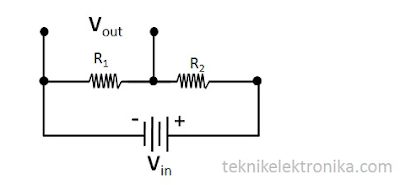Voltage Divider or voltage divider is a simple circuit that converts the voltage up to be a smaller voltage . The function of the voltage divider circuit in Electronics is to divide the input voltage to one or more of the output voltage required by other components in the circuit . Only by using two or more Resistors and Voltage Input , we have been able to make a simple voltage divider circuit .
Knowledge Voltage Dividers or Voltage Divider is very important and is a basic circuit that must be understood by every engineer or hobbyist Electronics.
There are two important part in designing the voltage divider circuit and Equality namely Voltage Dividers
Basically, the voltage divider circuit consisting of two resistors connected in series . Here is a simple circuit a voltage divider or Voltage Divider .
The formula / equation Voltage Dividers
Example Calculations voltage divider circuit Here are some examples of cases in the calculation of voltage divider circuit so that we got the desired voltage when designing an electronic circuit . Case 1 As an example , we give the input voltage of 9V at the voltage divider circuit to the value of R1 and R2 is 1000 Ohm is 220 Ohm Output Voltage on R1 what do we get?
Vin = 9V
R1 = 1000 Ohm
R2 = 220 Ohm
Vout = ?
Vout = Vin x (R1 / (R1+R2))
Vout = 9 x (1000/(1000+220))
Vout = 9 x (1000/1220)
Vout = 9 x 0.82
Vout = 7,38 Volt
Case 2
At the moment we designed a series of Electronics , we want to get 2,5V voltage of 9V input voltage by using a voltage divider circuit basis . What is the value of R1 and R2 we need to get the voltage we want ?
Vin = 9V
Vout = 2,5V
R1 = ?
R2 = ?
completion : The first step we must do is to determine the total value of R is desired, sample 1000 Ohm or R = R1 + R2 = 1000 Ohm . Note that the ratio R1 : R is the same as the ratio of V1 : V . In this case , V1 = 2,5V , so V1 : V = 2,5V / 9V = 0.28 . Therefore , the ratio R1 : R must also be 0.28 . Because the total value of R that we specify is 1000 Ohm then the comparison should also be R1 / 1000 = 0.28 . As a result, R1 = 280Ohm . To get the value of R2 , simply by making the reduction of 1000 Ohm - 280 Ohm = 720 Ohm .


Tidak ada komentar:
Posting Komentar